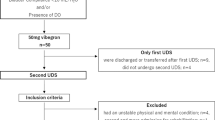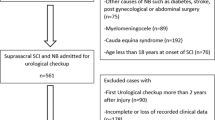Abstract
Study design
Secondary analysis of multicentre prospective observational data.
Objectives
To describe methods of bladder emptying at admission and discharge in patients with recently acquired spinal cord injury (SCI) and to describe predictors of bladder emptying methods at discharge.
Setting
First inpatient rehabilitation in specialised rehabilitation centres in the Netherlands.
Methods
Data from the Dutch Spinal Cord Injury Database collected between 2015 and 2019 were used. McNemar-Bowker test was used to evaluate if bladder emptying methods differed over time; One-Way ANOVA and Chi-Square tests to see if bladder emptying methods differed by demographic and injury-related characteristics. Binary logistic regression was used to predict the type of bladder emptying at discharge with demographic and injury-related characteristics measured at admission.
Results
Of 1403 patients, 44.1% had cervical, 38.4% thoracic and 17.5% lumbosacral lesions at admission. AIS classification was mostly D (63.8%). The method of bladder emptying changed significantly (p < 0.001) from admission to discharge: decrease of clean intermittent assisted catheterisation (17.1% to 4.1%) and indwelling catheter (33.4% to 16.3%) and increase in clean intermittent self-catheterisation (CISC, 7.8% to 22.2%) and normal voiding (40.2% to 56.1%). Age, sex, SCI level, AIS classification and level of independence predicted the method of bladder emptying at discharge (all p < 0.001).
Conclusions
During first inpatient rehabilitation, the method of bladder emptying changed resulting in more patients discharged with normal voiding and CISC. Age, sex, SCI level, AIS classification and level of independence in self-care were all confirmed as factors playing a role in this change.
This is a preview of subscription content, access via your institution
Access options
Subscribe to this journal
Receive 12 print issues and online access
$259.00 per year
only $21.58 per issue
Buy this article
- Purchase on Springer Link
- Instant access to full article PDF
Prices may be subject to local taxes which are calculated during checkout



Similar content being viewed by others
Data availability
The data analysed for this study are available from the corresponding author, upon reasonable request.
References
Kuris EO, Alsoof D, Osorio C, Daniels AH. Bowel and Bladder Care in Patients With Spinal Cord Injury. J Am Acad Orthop Surg. 2022;30:263–72.
Hamid R, Averbeck MA, Chiang H, Garcia A, Al Mousa RT, Oh SJ, et al. Epidemiology and pathophysiology of neurogenic bladder after spinal cord injury. World J Urology. 2018;36:1517–27.
Taweel WA, Seyam R. Neurogenic bladder in spinal cord injury patients. Res Rep Urol. 2015;7:85–99.
Bloemen-Vrencken JH, Post MW, Hendriks JM, De Reus EC, De, Witte LP. Health problems of persons with spinal cord injury living in the Netherlands. Disabil Rehabil. 2005;27:1381–9.
Piatt JA, Nagata S, Zahl M, Li J, Rosenbluth JP. Problematic secondary health conditions among adults with spinal cord injury and its impact on social participation and daily life. J Spinal Cord Med. 2016;39:693–8.
Consortium for Spinal Cord Medicine. Bladder management for adults with spinal cord injury: a clinical practice guideline for health-care providers. J Spinal Cord Medicine. 2006;29:527–73.
Adriaansen JJ, van Asbeck FW, Tepper M, Faber WX, Visser-Meily JM, de Kort LM, et al. Bladder-emptying methods, neurogenic lower urinary tract dysfunction and impact on quality of life in people with long-term spinal cord injury. J Spinal Cord Med. 2017;40:43–53.
Myers JB, Lenherr SM, Stoffel JT, Elliott SP, Presson AP, Zhang C, et al. Patient Reported Bladder Related Symptoms and Quality of Life after Spinal Cord Injury with Different Bladder Management Strategies. J Urology. 2019;202:574–84.
Lapides J, Diokno AC, Silber SJ, Lowe BS. Clean, intermittent self-catheterization in the treatment of urinary tract disease. J Urology. 1972;107:458–61.
Romo PGB, Smith CP, Cox A, Averbeck MA, Dowling C, Beckford C, et al. Non-surgical urologic management of neurogenic bladder after spinal cord injury. World J Urology. 2018;36:1555–68.
Weld KJ, Dmochowski RR. Effect of bladder management on urological complications in spinal cord injured patients. J Urology. 2000;163:768–72.
Linsenmeyer TA. Catheter-associated urinary tract infections in persons with neurogenic bladders. J Spinal Cord Medicine. 2018;41:132–41.
Cameron AP, Wallner LP, Tate DG, Sarma AV, Rodriguez GM, Clemens JQ. Bladder management after spinal cord injury in the United States 1972 to 2005. J Urology. 2010;184:213–7.
Singh R, Rohilla RK, Sangwan K, Siwach R, Magu NK, Sangwan SS. Bladder management methods and urological complications in spinal cord injury patients. Indian J Orthop. 2011;45:141–7.
Cameron AP, Wallner LP, Forchheimer MB, Clemens JQ, Dunn RL, Rodriguez G, et al. Medical and psychosocial complications associated with method of bladder management after traumatic spinal cord injury. Archives Physical Medicine Rehabilitation. 2011;92:449–56.
Baradaran N, Peng J, Palettas M, Chen Y, DeVivo MJ, Schwab JM. Bladder Management With Chronic Indwelling Catheter is Associated with Elevated Mortality in Patients with Spinal Cord Injury. Urology. 2022;165:72–80.
Blok B, Pannek J, Castro Diaz D, Del Popolo G, Gross T, Hamid R, et al. European Association of Urology Guidelines on Neuro-Urology.; Available from: https://uroweb.org/guideline/neuro-urology/#3. Accessed on: December 2021.
Afsar SI, Yemisci OU, Cosar SN, Cetin N. Compliance with clean intermittent catheterization in spinal cord injury patients: a long-term follow-up study. Spinal Cord. 2013;51:645–9.
Oh SW, Jung JH, Cho IK, Lee HJ, Kwon SH, Lee BS. Changes in the Trend in Bladder Emptying Methods in Patients With Spinal Cord Injury: A 20-Year Single-Center Retrospective Study. Annals Rehabilitation Medicine. 2020;44:228–37.
Post MWM, Nachtegaal J, van Langeveld SA, van de Graaf M, Faber WX, Roels EH, et al. Progress of the Dutch Spinal Cord Injury Database: Completeness of Database and Profile of Patients Admitted for Inpatient Rehabilitation in 2015. Top Spinal Cord Inj Rehabil. 2018;24:141–50.
Biering-Sørensen F, Craggs M, Kennelly M, Schick E, Wyndaele JJ. International lower urinary tract function basic spinal cord injury data set. Spinal Cord. 2008;46:325–30.
Itzkovich M, Gelernter I, Biering-Sorensen F, Weeks C, Laramee MT, Craven BC, et al. The Spinal Cord Independence Measure (SCIM) version III: reliability and validity in a multi-center international study. Disabil Rehabil. 2007;29:1926–33.
Kirshblum SC, Burns SP, Biering-Sorensen F, Donovan W, Graves DE, Jha A, et al. International standards for neurological classification of spinal cord injury (revised 2011). J Spinal Cord Medicine. 2011;34:535–46.
Krebs J, Wöllner J, Rademacher F, Pannek J. Bladder management in individuals with spinal cord injury or disease during and after primary rehabilitation: a retrospective cohort study. World J Urology. 2022;40:1737–42.
Zlatev DV, Shem K, Elliott CS. Predictors of long-term bladder management in spinal cord injury patients-Upper extremity function may matter most. Neurourology Uurodynamics. 2018;37:1106–12.
Lucas E. Medical Management of Neurogenic Bladder for Children and Adults: A Review. Top Spinal Cord Inj Rehabil. 2019;25:195–204.
Gurcay E, Bal A, Eksioglu E, Cakci A. Quality of life in patients with spinal cord injury. Int J Rehabil Res. 2010;33:356–8.
Lane GI, Driscoll A, Tawfik K, Chrouser K. A cross-sectional study of the catheter management of neurogenic bladder after traumatic spinal cord injury. Neurourology Urodynamics. 2018;37:360–7.
Central Committee on Research Involving Human Subjects: File research; Available from: https://english.ccmo.nl/investigators/additional-requirements-for-certain-types-of-research/non-wmo-research/file-research. Accessed on: June 2023.
Acknowledgements
The Dutch Spinal Cord Injury Database (DSCID) is a collaboration of the Dutch-Flemish Spinal Cord Society (DuFSCOS), including Adelante: J. Hermans, C.C.M. van Laake-Geelen; Rehabilitation Centre De Hoogstraat: C.A. Dijkstra, J.M. Stolwijk-Swüste; Rehabilitation Centre Heliomare: W.X.M. Faber, D. Gobets; Rehabilitation Centre Het Roessingh: N. Jacobs, E.M. Maas, J. Snijders-Schuttevaar; Rehabilitation Centre Reade: J.J.E. Adriaansen, W.J. Achterberg-Warmer; Rehabilitation Centre Sint Maartenskliniek: H. Bongers-Janssen, I.J.W. van Nes, M. Vos-van der Hulst; Rijndam Rehabilitation: D.C.M. Spijkerman, R. Osterthun, T. Sluis; and UMCG Centre for Rehabilitation: G.E. van der Wal, E.H. Roels, M. Tepper. The DSCID project management group consists of C.A.M. van Bennekom, J. Nachtgaal, R. Osterthun, M.W.M. Post, E.H. Roels, E.W.M. Scholten and J.M. Stolwijk-Swüste.
Funding
Quality Funds Foundation of Dutch Medical Specialists (SKMS; grant no. Z69044861).
Author information
Authors and Affiliations
Contributions
CP writing the paper with input from all authors. CP, ES, MP conceiving and designing the analysis. CP, ES analysing data. CP, ES, MW, MP, JS interpreting results. ES, MW, MP, JS feedback on the report. JS supervised.
Corresponding author
Ethics declarations
Competing interests
The authors declare no competing interests.
Ethical approval
The DSCID did not need formal ethical approval because this type of study does not fall within the scope of the Dutch law on Medical Research [29]. Nevertheless, the local ethical committees and boards of all participating centres approved the provision of anonymized data on their patients for the DSCID. This study was conducted according to the Helsinki II declaration.
Additional information
Publisher’s note Springer Nature remains neutral with regard to jurisdictional claims in published maps and institutional affiliations.
Supplementary information
Rights and permissions
Springer Nature or its licensor (e.g. a society or other partner) holds exclusive rights to this article under a publishing agreement with the author(s) or other rightsholder(s); author self-archiving of the accepted manuscript version of this article is solely governed by the terms of such publishing agreement and applicable law.
About this article
Cite this article
Poublon, C.G., Scholten, E.W.M., Wyndaele, M.I.A. et al. Changes in bladder emptying during inpatient rehabilitation after spinal cord injury and predicting factors: data from the Dutch Spinal Cord Injury Database. Spinal Cord 61, 624–631 (2023). https://doi.org/10.1038/s41393-023-00925-y
Received:
Revised:
Accepted:
Published:
Issue Date:
DOI: https://doi.org/10.1038/s41393-023-00925-y



